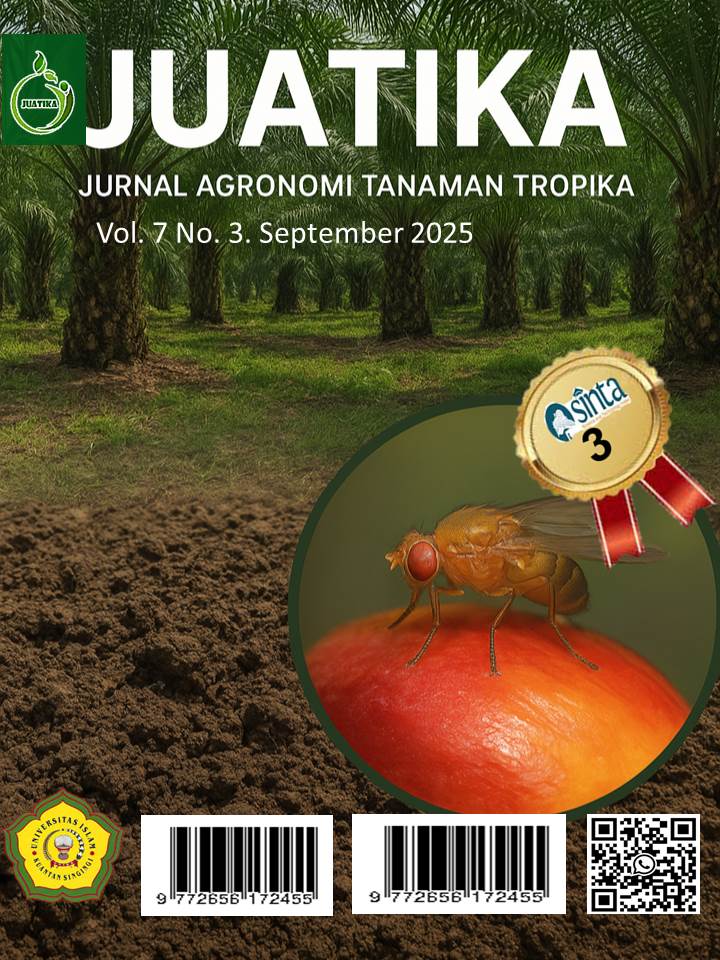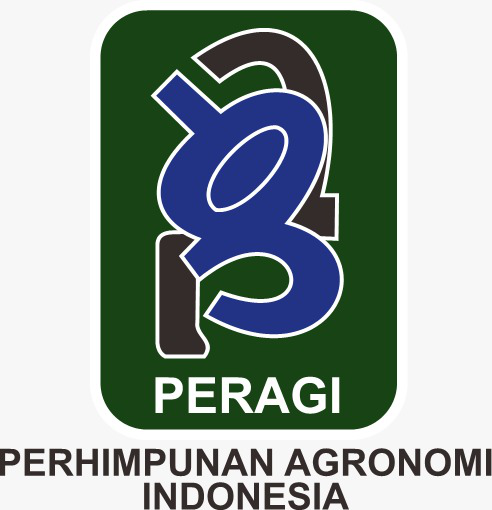Correlation of Aloe Vera-Based Liquid Organic Fertilizer with Growth Traits of Oil Palm (Elaeis guineensis Jacq.)
Abstract
Aloe vera gel contains various secondary metabolites that contribute to the plant’s beneficial properties. This study employed a correlation analysis test to investigate the relationship between Aloe vera LOF dosage and S.H, S.D, and NL in Oil Palm Seedlings (Elaeis guineensis Jacq.). This study was conducted in a controlled experimental garden managed by the Plantation Management Study Program at the Politeknik Indonesia Venezuela, located in Cot Suruy Village, Ingin Jaya District, Aceh Besar Regency. The study was conducted from March to July 2025. The garden temperature was maintained between 25°C and 28°C. Data analysis was carried out using SPSS 25 software. To see the correlation analysis between LOF, SH, SD, and NL in Oil Palm Seedlings (Elaeis guineensis Jacq.), a bivariate CA was used. The use of Aloe vera LOF at various doses (100–400 ml) was proven to have a significant effect on the vegetative growth of oil palm seedlings, especially on PH, SD, and NL. Aloe vera LOF, as a natural leaf fertiliser, can provide a significant positive effect on the vegetative growth of oil palm seedlings by increasing the height, diameter, and NL simultaneously.
Downloads
References
Abdullah, U. H., Nurfaizah, N., Yana, D., Akbar, H., Wilis, R., & Rosa, E. (2024). Correlation analysis between watering interval, stem height, stem diameter, and number of leaves in jackfruit seedlings (Artocarpus heterophyllus Lamk). JERAMI: Indonesian Journal of Crop Science, 7(1), 10–17. https://doi.org/10.25077/jijcs.7.2.13-16.2024
Adu, M. O., Atia, K., Arthur, E., Asare, P. A., Obour, P. B., Danso, E. O., ... & Andersen, M. N. (2022). The use of oil palm empty fruit bunches as a soil amendment to enhance crop growth and yield: A meta-analysis. Agronomy for Sustainable Development, 42(2), 13. https://doi.org/10.1007/s13593-022-00753-z
Afifah, E. N., Sari, I. A., Susilo, A. W., Firmanto, H., Malik, A., Fukusaki, E., & Putri, S. P. (2025). Correlation between sensory attributes and metabolomic profiles of cocoa liquor from different cacao genotypes. Food Chemistry: X, 102498. https://doi.org/10.1016/j.fochx.2025.102498
Ajeng, A. A., Abdullah, R., Malek, M. A., Chew, K. W., Ho, Y. C., Ling, T. C., ... & Show, P. L. (2020). The effects of biofertilizers on growth, soil fertility, and nutrient uptake of oil palm (Elaeis guineensis) under greenhouse conditions. Processes, 8(12), 1681. https://doi.org/10.3390/pr8121681
Al-Huqail, A. A., Kumar, P., Kumari, S., & Eid, E. M. (2023). Biosolids application enhances the growth of Aloe vera plants and provides a sustainable practice for nutrient recirculation in agricultural soils. Environmental Science and Pollution Research, 30(47), 104246–104257. https://doi.org/10.1007/s11356-023-29763-4
Ariyanti, M., Maxiselly, Y., Rosniawaty, S., & Indrawan, R. A. (2019). The growth of oil palm with oil palm midrib organic fertiliser and humic acid. Jurnal Penelitian Kelapa Sawit, 27(2), 71–82. https://doi.org/10.22302/iopri.jur.jpks.v27i2.84
Canche-Escamilla, G., Colli-Acevedo, P., Borges-Argaez, R., Quintana-Owen, P., May-Crespo, J. F., Cáceres-Farfan, M., Yam Puc, J. A., Sansores-Peraza, P., & Vera-Ku, B. M. (2019). Extraction of phenolic components from an Aloe vera (Aloe barbadensis Miller) crop and their potential as antimicrobials and textile dyes. Sustainable Chemistry and Pharmacy, 14, 100168. https://doi.org/10.1016/j.scp.2019.100168
Chen, Y., Camps-Arbestain, M., Shen, Q., Singh, B., & Cayuela, M. L. (2018). The long-term role of organic amendments in building soil nutrient fertility: A meta-analysis and review. Nutrient Cycling in Agroecosystems, 111(2), 103–125. https://doi.org/10.1007/s10705-017-9903-5
Cheena, J., Veni, V. K., & Sreenivas, M. (2022). Effect of different organic manures and biofertilizers on growth and yield of aloe (Aloe barbadensis). The Pharma Innovation Journal, 11(5), 265–268.
Chowdhury, T., Chowdhury, M. A. H., Qingyue, W., Enyoh, C. E., Wang, W., & Khan, M. S. I. (2021). Nutrient uptake and pharmaceutical compounds of Aloe vera as influenced by integration of inorganic fertiliser and poultry manure in soil. Heliyon, 7(7), e07464. https://doi.org/10.1016/j.heliyon.2021.e07464
Corley, R. H. V., & Tinker, P. B. (2016). The oil palm. Wiley Blackwell. https://doi.org/10.1002/9781118953297
Cui, J., Lamade, E., & Tcherkez, G. (2020). Seed germination in oil palm (Elaeis guineensis Jacq.): A review of metabolic pathways and control mechanisms. International Journal of Molecular Sciences, 21(12), 4227. https://doi.org/10.3390/ijms21124227
Dubos, B., & De Raïssac, M. (2021). El Niño modifies nutrient status in oil palm and helps foliage to recover from yellowing symptoms: New analysis and perspectives. Cahiers Agricultures, 30, 34. https://doi.org/10.1051/cagri/2021021
El Sheriff, F. (2017). Aloe vera leaf extract as a potential growth enhancer for Populus trees grown under in vitro conditions. American Journal of Plant Biology, 2(4), 101–105. https://doi.org/10.11648/j.ajpb.20170203.13
Gunawan, M. F., Subroto, G., Savitri, D. A., & Farisi, O. A. (2024). Effect of dose and type of liquid organic fertiliser on early growth of cocoa seedlings (Theobroma cacao L.). Protech Biosystems Journal, 3(2), 102–109.
He, C., Wu, K., Zhang, J., Liu, X., Zeng, S., Yu, Z., Zhang, X., Teixeira da Silva, J. A., Deng, R., & Tan, J. (2017). Cytochemical localisation of polysaccharides in Dendrobium officinale and the involvement of DoCSLA6 in the synthesis of mannan polysaccharides. Frontiers in Plant Science, 8, 173. https://doi.org/10.3389/fpls.2017.00173
Husna, M., Salamah, U., Herman, W., & Agwil, W. (2023). The improvement of oil palm seedlings through shade, manure, and organic liquid fertiliser in Ultisol media. Planta Tropika, 11(1), 33–40. https://doi.org/10.18196/pt.v11i1.13415
Irmadhani, D., & Dewi, S. K. (2025). Efektivitas ZPT alami dari filtrat bawang merah dan lidah buaya terhadap pertumbuhan tanaman cabai rawit (Capsicum frutescens L.). LenteraBio: Berkala Ilmiah Biologi, 14(1), 35–41. https://doi.org/10.26740/lenterabio.v14n1.p35-41
Kédagni, D., & Mourifié, I. (2020). Generalized instrumental inequalities: Testing the instrumental variable independence assumption. Biometrika, 107(1), 35–47. https://doi.org/10.1093/biomet/asz051
Kumar, S., Kumar, R., & Dahiya, D. S. (2017). Effect of organic manures and biofertilizers on growth, yield, and quality of Aloe vera under semi-arid conditions. Indian Journal of Agricultural Research, 51(6), 594–598. https://doi.org/10.18805/IJARe.A-328
Liang, Y., Li, S., & Xu, Q. (2022). Long-term application of organic amendments improves soil fertility and crop productivity in tropical regions: A meta-analysis. Soil and Tillage Research, 220, 105354. https://doi.org/10.1016/j.still.2022.105354
Lombardi, N., Vitale, S., Turrà, D., Reverberi, M., Fanelli, C., Zjalic, S., ... & Altomare, C. (2018). Root exudates of stressed plants stimulate and attract Trichoderma soil fungi. Molecular Plant-Microbe Interactions, 31(10), 982–994. https://doi.org/10.1094/MPMI-01-18-0019-R
Lu, J., Yang, R., Zhao, H., Liu, B., Yang, Y., & Zeng, Y. (2019). Influence of Aloe vera extract on growth and physiological characteristics of wheat seedlings under drought stress. Plant Physiology and Biochemistry, 145, 197–205. https://doi.org/10.1016/j.plaphy.2019.10.029
Mahlia, T. M. I., Ismail, N., Hossain, M. A., & Silitonga, A. S. (2019). Palm oil and its sustainability: Challenges and opportunities. Renewable and Sustainable Energy Reviews, 110, 575–589. https://doi.org/10.1016/j.rser.2019.05.032
Mansor, M., Nor, N. M., & Wahab, N. A. (2021). Use of oil palm biomass for sustainable agriculture: A review. Sustainability, 13(18), 10447. https://doi.org/10.3390/su131810447
Manurung, E., Sembiring, M., & Situmeang, B. (2020). Pengaruh pemberian pupuk organik cair lidah buaya (Aloe vera) terhadap pertumbuhan bibit kelapa sawit (Elaeis guineensis Jacq.) di pembibitan awal. Jurnal Agroekoteknologi FP USU, 8(1), 76–82.
Marbun, M. S., Lubis, R., & Sitepu, I. R. (2023). Pengaruh kombinasi pupuk organik cair lidah buaya dan pupuk kandang ayam terhadap pertumbuhan bibit kakao (Theobroma cacao L.). Agroteknologi Tropika, 12(2), 92–98.
Martínez-González, J. C., González-Chávez, M. C. A., & Carrillo-González, R. (2017). Impact of organic amendments on the growth of Aloe vera and the dynamics of soil carbon and nitrogen in semiarid degraded soils. Journal of Arid Environments, 142, 16–24. https://doi.org/10.1016/j.jaridenv.2017.03.001
Munyuli, T., Wale, E., & Mungai, N. (2022). Biofertilizer use in Sub-Saharan Africa: A review of impacts on soil health and crop yield. Agronomy, 12(1), 114. https://doi.org/10.3390/agronomy12010114
Ndukwe, O. K., Akubugwo, E. I., & Onwuka, G. I. (2020). Comparative evaluation of Aloe vera leaf and cow dung as organic fertilisers on maize (Zea mays L.) performance. Journal of Applied Science and Environmental Management, 24(1), 49–54. https://doi.org/10.4314/jasem.v24i1.8
Nurtjahya, E., & Suyono, S. (2021). Growth response of oil palm seedlings (Elaeis guineensis Jacq.) to biofertilizer and organic matter application. Jurnal Tanah dan Iklim, 45(2), 127–136. https://doi.org/10.21082/jti.v45n2.2021.127-136
Okoroafor, U. C., & Ndukwe, O. K. (2021). Growth response of maize (Zea mays L.) to combined application of Aloe vera extract and NPK fertilizer. Nigerian Journal of Agricultural Science, 3(1), 18–24.
Panjaitan, S., Mulyadi, A., & Lubis, A. (2024). Pemberian kombinasi pupuk organik cair lidah buaya (Aloe vera) dan pupuk kandang sapi terhadap pertumbuhan bibit kelapa sawit (Elaeis guineensis Jacq.). Jurnal Pertanian Tropika, 11(1), 23–29.
Rahman, S. A., Hashim, Z., & Nor, N. M. (2023). Integrated use of organic and inorganic fertilisers for sustainable oil palm production. International Journal of Agricultural Sustainability, 21(5), 678–691. https://doi.org/10.1080/14735903.2023.2175528
Rao, R., Rao, M., & Hossain, M. (2020). Organic amendments improve nutrient availability and soil health in tropical agriculture: A review. Soil Systems, 4(4), 70. https://doi.org/10.3390/soilsystems4040070
Rini, K. S., & Sulastri, L. (2023). Respon pertumbuhan bibit kelapa sawit (Elaeis guineensis Jacq.) terhadap pemberian pupuk organik cair lidah buaya (Aloe vera). Agrotek Indonesia, 8(1), 12–19.
Sembiring, D., Lubis, R., & Silaban, B. (2022). Pengaruh pemberian pupuk organik cair lidah buaya (Aloe vera) terhadap pertumbuhan bibit kelapa sawit (Elaeis guineensis Jacq.) di pembibitan utama. Jurnal Agroekoteknologi FP USU, 10(2), 112–120.
Singh, V. P., & Kumar, P. (2019). Role of Aloe vera in sustainable agriculture: A review. International Journal of Current Microbiology and Applied Sciences, 8(5), 2256–2264. https://doi.org/10.20546/ijcmas.2019.805.265
Situmorang, M., & Lubis, R. (2021). Pengaruh pemberian pupuk organik cair lidah buaya (Aloe vera) terhadap pertumbuhan bibit kelapa sawit (Elaeis guineensis Jacq.) di media gambut. Jurnal Pertanian Tropika, 10(2), 65–71.
Suhartono, R., Santoso, B. B., & Wijayanti, M. (2022). Application of compost and liquid organic fertiliser improves soil fertility and growth of Elaeis guineensis. Tropical Plantation Journal, 9(2), 102–110.
Tampubolon, D., Nasution, E. H., & Simanjuntak, P. (2023). Pengaruh pupuk organik cair lidah buaya terhadap pertumbuhan bibit kelapa sawit (Elaeis guineensis Jacq.). Jurnal Agroteknologi Tropika, 11(2), 87–93.
Umar, S., Yusuf, R., & Natsir, M. (2024). Growth and physiological response of oil palm (Elaeis guineensis Jacq.) seedlings to organic fertiliser application. Indonesian Journal of Agricultural Research, 7(1), 22–29.
Wang, J., Zhang, L., & Yang, C. (2023). Effect of organic liquid fertilisers on photosynthetic rate and biomass accumulation in tropical perennial crops. Agronomy Journal, 115(4), 1678–1687. https://doi.org/10.1002/agj2.21113
Zhou, Y., Zhu, Y., & Wong, W. K. (2023). Biochar and organic fertiliser co-application enhances nutrient cycling and carbon sequestration in oil palm plantations. Environmental Research, 232, 116325. https://doi.org/10.1016/j.envres.2023.116325
Copyright (c) 2025 Umar H A, Ruhalena Wilis, Elviani, Nurlia Farida, Khairun Nisa

This work is licensed under a Creative Commons Attribution 4.0 International License.
Authors who publish with Jurnal Agronomi Tanaman Tropika (JUATIKA) agree to the following terms:
Authors retain copyright and grant the Jurnal Agronomi Tanaman Tropika (JUATIKA) right of first publication with the work simultaneously licensed under a Creative Commons Attribution License (CC BY 4.0) that allows others to share (copy and redistribute the material in any medium or format) and adapt (remix, transform, and build upon the material for any purpose, even commercially) with an acknowledgment of the work's authorship and initial publication in Jurnal Agronomi Tanaman Tropika (JUATIKA).
Authors are able to enter into separate, additional contractual arrangements for the non-exclusive distribution of the journal's published version of the work (e.g., post it to an institutional repository or publish it in a book), with an acknowledgment of its initial publication in Jurnal Agronomi Tanaman Tropika (JUATIKA). Authors are permitted and encouraged to post their work online (e.g., in institutional repositories or on their website) prior to and during the submission process, as it can lead to productive exchanges, as well as earlier and greater citation of published work.







 More Information
More Information



